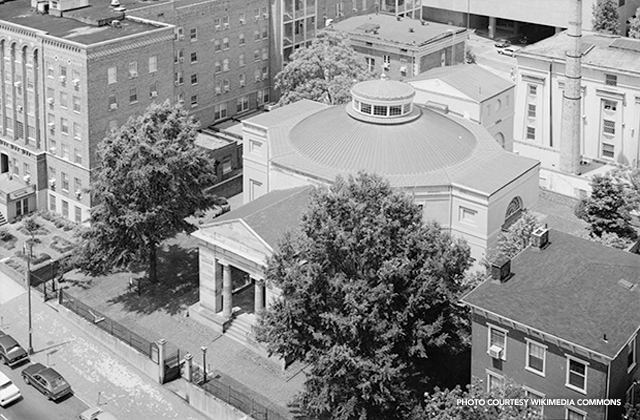More Monumental Structures by Robert Mills
The Fall 2015 issue of Preservation magazine highlights the recent preservation of the Washington Monument in Baltimore. The 1829 structure, as well as its Washington, D.C. counterpart, was designed by one of the first American-born architects, Robert Mills. Here, we feature four more highlights of Mills' architectural career.

The sturdy Fireproof Building in Charleston, South Carolina.
Fireproof Building (County Records Building)
Year built: 1827
Purpose: Housing county records
Location: Charleston, South Carolina
Current Status: Home to the South Carolina Historical Society
The County Records Building in Charleston, South Carolina is better known as the Fireproof Building. It is perhaps the oldest fire-resistant building in the country and was certainly the most fireproof in its time. Fire was a significant issue that Mills addressed in his designs, perhaps because of tragedies he encountered during his career. For this structure, Mills hoped to protect county records with brick walls, iron-framed windows, and a copper roof (later replaced with tin). Today the Greek Revival building houses the South Carolina Historical Society.

Monumental Church in Richmond, Virginia, with its unique Delorme dome roof.
Monumental Church
Year built: 1814
Purpose: Honoring victims of the 1811 Richmond Theater fire.
Location: Richmond, Virginia
Current Status: Open for tours, private functions, weddings, etc.
The Monumental Church sits atop what was once the site of the Richmond Theater. In 1811, however, a fire destroyed the wooden entertainment house and claimed 72 victims. A year later, Mills was asked by Chief Justice John Marshall to design a church to replace the theater and serve the community as a place for gathering and healing. It hosted active congregations until 1965. Famous church attendees and visitors include Chief Justice John Marshall, Edgar Allen Poe, and the Marquis de Lafayette.

United States Customs House in New Bedford, which still serves the same purpose for which it was built.
United States Customs House
Year built: 1836
Purpose: Customs house
Location: New Bedford, Massachusetts
Current Status: Customs house, port of entry
There are four historic customs houses designed by Robert Mills (two in Connecticut, two in Massachusetts), but the largest and most elaborate is this one in New Bedford. The structure was originally slated to be built with bricks and wood frames, but Mills suggested solid stone. Authorized by an Act of Congress in 1832, the building even hosted whalers who came to register their ships and goods. The structure is now the oldest continually operating customs house in the United States.

The Old Patent Office Building is now known as the Donald W. Reynolds Center in Washington, D.C.
Old Patent Office Building/Donald W. Reynolds Center for American Art and Portraiture
Year built: 1867
Purpose: Housing patent records and models
Location: Washington D.C.
Current Status: Home to the Smithsonian American Art Museum and National Portrait Gallery.
Walt Whitman once called the Old Patent Office Building the “noblest of Washington buildings.” Now known as the Donald W. Reynolds Center after a generous donation for its renovation, the structure sits between the U.S. Capitol Building and the White House. While Mills designed much of the interior and supervised the construction, it was largely Ithiel Town and William P. Elliot who designed the exterior with its Greek Parthenon-inspired central portico. Wooden beams were avoided in favor of masonry vaulting to protect the interior walls from fire, but even these precautions did not prevent a large blaze in the west wing in 1877. Though the structure remained largely intact, many patent records and scale models were destroyed. After the fire, the structure was used by various government entities until it became part of the Smithsonian Institution in 1958.



